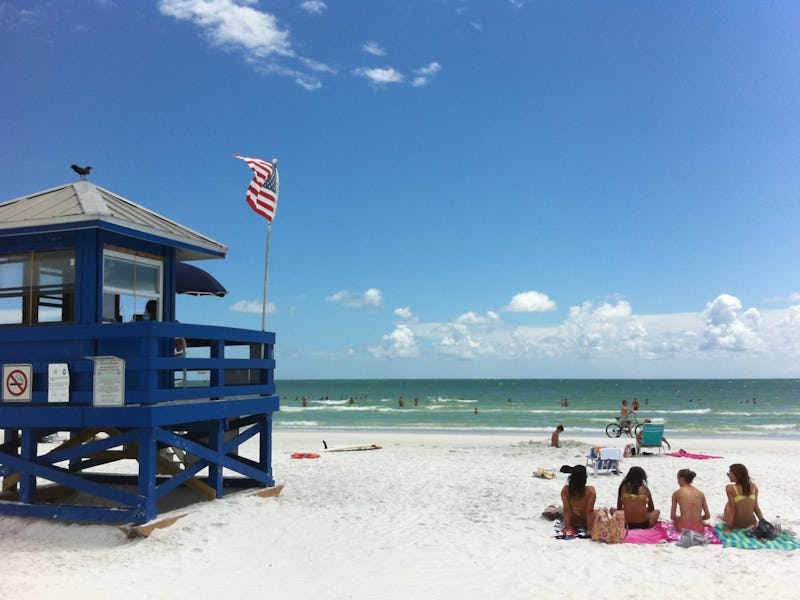Science Has Crowned This the Most Perfect Beach in America
It takes many millions of years to make the world's best sand.

Stephen Leatherman loves beaches. “I love waves; I love the salty air; I love seafood; I love fishing, boating, body boarding, riding the waves — just about everything about it,” he tells Inverse.
As a geologist and coastal scientist, Leatherman has researched beaches professionally for decades. He started out watching storms and studied patterns of erosion, but he’s equally preoccupied with a more pleasant question: What makes a perfect beach?
Leatherman, who also goes by “Dr. Beach,” releases an annual ranking of United States beaches, and this year’s big winner is Siesta Beach in Sarasota, Florida, known for its expanse of powdery white sand. “It just feels so good to walk on it, he says. “If you wear your shoes on that beach, you’re not getting the full experience.”
The rankings are scientific only insofar as you agree with the system that produces them. Leatherman has developed 50 criteria, and each is ranked on a scale from one to five. These are large, public beaches, and he’s looking for the sorts of things that would make them attractive to a large number of people: warm, clear water; nice sand, and lots of it; safe swimming; and a natural setting.
Whether Siesta Beach is your ideal beach or not, some incredible feats of geology made it. Tens of millions of years ago, great rivers flowed south, all the way from the Appalachian Mountains to the Gulf of Mexico, carrying enormous volumes of sand and sediment.
But over time, the courses of the rivers shifted, until they no longer flowed all the way south, and the place that would become Florida was cut off permanently from its source of sand. “Today, there’s not a river in Florida that carries any real sand,” says Leatherman. It’s just too slow a flow.”
Those early beaches would have been made up of the coarse, brownish sand that is common in many places on the planet. If you looked closely, you’d see a great diversity of mineral types, colors, shapes, and sizes. But over time, the steady pounding of the waves and chemical interactions with the water broke down those minerals until all of them eroded away into dust.
Well — almost all of them. Those minerals ground down and flushed away until just one thing was left — tiny quartz crystals of an identical shape and size. Quartz is the hardest and most stable common mineral on Earth, and when the crystals grind down they will eventually reach what is known as their “terminal size,” at which they are even more stable and resistant to erosion than before.
It is these crystals of terminal size that make up the powder white beaches of many parts of Florida. Once everything else had eroded away, these beaches reached a geological equilibrium, with particles of just the right size so that they would be trapped indefinitely by the action of the waves.
But climate change hasn’t let “indefinitely” stay, well, indefinite. Today, it — along with other natural processes — threatens to steal Florida’s perfect sand. The land is subsiding — literally sinking — along the Atlantic coast of the United States because of processes set in motion by the melting of ice at the end of the last ice age. Human activities like groundwater pumping contribute to subsidence, causing the land to sink even further.
And then there’s sea level rise. Global warming is melting ice caps and glaciers, which adds volume to the world’s oceans. It also increases the water temperature, which causes the seas to physically take up more room.
Climate change is brewing fiercer storms, too, and hurricanes sweep beaches away to the ocean. Some of that sand will come back with the gentle action of waves later on, but with increasingly frequent and intense storms, more and more of it won’t.
All of this has disrupted the natural equilibrium of Florida’s beaches such that more sand is washing away than is being pushed back in. The result is a Siesta Beach engineered less by geology and more by humans — in 2007 Sarasota County spent $9 million to dredge 887,400 cubic yards of sand from deeper parts of the ocean back onto the beach.
Replenishing a beach in this way is inevitably a temporary solution. Nature will always push back to its point of balance, and that point of balance has shifted to a less sandy Florida.
But the money spent might be worth it — who doesn’t love a perfect beach?